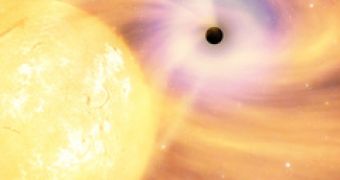The Milky Way, like many other spiral galaxies, is home to a colossal black hole smack in its center, which is though to be the object which keeps most of the galaxy from falling apart. But with billions of other stars, having masses over 5 times that of the Sun, it's natural to imagine that the universe, thus our galaxy, is abundant in black holes. A new computer simulation made by Kelly Holley-Bockelmann from the Vanderbilt University seems to confirm the predictions.
Most of them are thought to have formed in the first moments of the universe's life, and while some were relatively unstable and evaporated through what we now call Hawking radiation, others might still exist even today. The vast majority of the black holes population, however, is considered to have originated in collapsed stellar cores. Some theories even predict that microscopic black holes may pop in and out of existence throughout the whole space-time fabric of the universe.
Stellar black holes are created in the final stages of a star's life, and, according to theoretical calculations, have masses equal or greater to 5 solar masses, as the star goes supernova and compresses its core until the gravitational force of the object suppresses all the nuclear forces of matter, which determines a gravitational collapse that turns the core into a singularity, a theoretical point-like object with zero volume, but incredible mass and gravitational field.
Although physics predicts that naked singularities are allowed to exist in the space-time fabric of space, most of the black hole, as their name states, are surrounded by a event horizon that has the characteristics of the black body, meaning it does not give off electromagnetic radiation, thus the singularity is hidden away from any outside observer. Once matter and energy passes the event horizon of a black hole, it is destined to ultimately hit the singularity, and would remain there forever.
As you can see from the description, a black hole is invisible to electromagnetic waves, thus any attempts to detect them through such methods are useless. So astronomers use gravitational effects to discover potential black holes, such as gravitational lensing with light amplification effect similar to that of the optical lenses commonly used on Earth. However, the effect is achieved through a totally different process; while optical lenses bend light by a refraction effect as the light travels through the mass of the lens, black holes bend light by curving the fabric of space.
A second method frequently used to detect black holes is to observe the radiation emitted during the 'feeding' process of a black hole. Such objects are mostly known as quasars, and emit high levels of gamma ray and X-ray radiations, as the accretion disks spinning around them heat up to very high temperatures.
Similarly to the stars, black holes can be usually found in the place of the original stars that gave birth to them, but occasionally they are ejected from certain stellar systems and wonder through space, devouring everything in their path, or merging with other black holes or neutron stars. Scientists call these types of cosmic objects 'rogue black holes' as they travel through galaxies at incredible speeds.
A black hole merger is one of the most violent events which take place in the universe, creating powerful gravitational waves, which can propel the merger at speeds as high as 4,000 kilometers per second, and strong gamma ray radiation emissions.
The simulations made by Holly-Bockelmann and her colleagues mostly focused on black holes with masses only a few thousand times that of the Sun, and, although their existence hasn't escaped debate yet, they were proven to release enough energy during a merge, energy that could propel an object inside a globular star cluster at speeds of at least 100 kilometers per second.
According to the data resulted from the computer simulations, stellar black holes with masses comparable to that of the Sun populating a globular star cluster could represent only 30 percent of the original black hole, after a merging. This means that, if all the globular star clusters currently known in the Milky Way would have had a black hole with intermediate mass, about 100 or more of them would now be wandering invisibly through the interstellar space.

 14 DAY TRIAL //
14 DAY TRIAL //